If you’re reading this, chances are you’re looking to start an ecommerce business. Perhaps you already have a product in mind, and you want to open an online store so you can sell it to the world. Or, maybe you don’t have a product yet, but you see the potential of the ecommerce market (eMarketer estimates online sales will top $27 trillion in 2020), and you’re looking to get a piece of the action.
Quick Guide to Start Your First Ecommerce Business
Determine what you want to sell
You can ship any product to anywhere in the world these days? What do you choose?
How to source your products – finding suppliers
Offshore, onshore or dropship? How do you find trustworth suppliers?
Iron out your ecommerce technology and solutions
A minefield of options, do you go for the cheapest solution?
Sort Out the Payments side of things
Paypal, Stripe or Braintree?
Measure business performance
How do you measure ecommerce success?
Whatever the case, we have some good news: there has never been a better time to start an ecommerce business. Thanks to ecommerce platforms such as Magento, Shopify, BigCommerce, and the like, getting an online business up and running is easier and more cost-effective than ever before.
Ecommerce solutions and the internet have levelled the playing field and lowered the barrier to entry so creative, entrepreneurial individuals can start and grow an ecommerce business with ease (i.e., There’s no coding or a huge financial investment required.).
The challenge, though, lies in the overwhelm that you may experience when you’re starting out. Entrepreneurs today have so many choices, and there’s a ton of information out there, that it can be crippling to figure out the best route for your online store.
If you’re in the same boat, then keep reading. In this comprehensive guide, we’ll walk you through all the important steps you should take to get your ecommerce business off the ground.
Let’s get started with the most important questions you need to ask yourself before you open your first online store.
Step 1: Determine what you want to sell
The first step of starting an ecommerce business is deciding what you want to sell. Inventory is the lifeblood of any ecommerce business, so you want to make sure you get this right. That’s why we’ll share a few tips on how to decide what products to sell and how to source your merchandise.
Do you want to source products from other creators or manufacturers or manufacture them yourself?
There are plenty of reasons why you would want to manufacture your own products. While this comes with a couple of challenges (committing to an idea, high manufacturing costs), it’s a great option for those who want to be in control of the final price of the product, where to sell it, and how to go about selling it.
Not too keen on making your products? Your other option is to obtain them from other creators or manufacturers. When you go this route, you can choose to stock up on merchandise and hold products as inventory, or you could go the dropshipping route by arranging the items to be shipped directly from the manufacturer.
But before diving into business with a manufacturer or committing to selling your own creation, you not only need to ask yourself what exactly should you sell but, more importantly, will people buy it?
In other words, you need to research your target market and figure out which products are ideal to sell online and if there is a demand for them.
So, how should you go about this? We’ll tackle this in detail next.
What are your interests and skills?
For some people, finding a product is very easy. Artists, crafters, and designers, typically belong to this group, as they often venture into ecommerce to sell their own creations.
It might make sense for you to go down a similar path. Think about your hobbies, interests or things you’re good at. Try to use your knowledge and experience to create products that customers would love.
One ecommerce entrepreneur who is a perfect example of this is Steve Gadlin – the man who started IWanttoDrawaCatForYou.com. Steve was a website development manager by day, but he also pursued other things (including comedy) on the side.
He used his creativity and sense of humour to start IWanttoDrawaCatForYou, a website that allowed people to order custom cat drawings from Steve. It might have started off as an experiment, but it eventually grew into a full-fledged ecommerce business.

Steve even secured an investment from Mark Cuban after appearing on the hit show Shark Tank, and according to the Business Insider, this ecommerce business went on to earn $200,000 after ending up on the show. Steve has since closed down the ecommerce business to pursue other endeavours, but IWanttoDrawaCatForYou.com remains an interesting success story of what could happen if you used your creativity to create something that people love.
Explore popular online listings
So, you think you have a pretty good idea but you need to make sure there’s demand. One way to gauge demand is to see what people are in need of. An easy way to do this is to check the popular listings on sites such as eBay, Etsy, Craigslist, and Amazon. For instance, on eBay, you can head to ebay.com/trending, a page that displays the most recently popular items on the site.

If you already have a product in mind and want insight into consumer demand, you can visit explore.ebay.com, which lets you conduct trend searches for specific items. There are also third-party tools like WatchCount.com, which enable you to “discover which eBay items have attracted the most interest.”
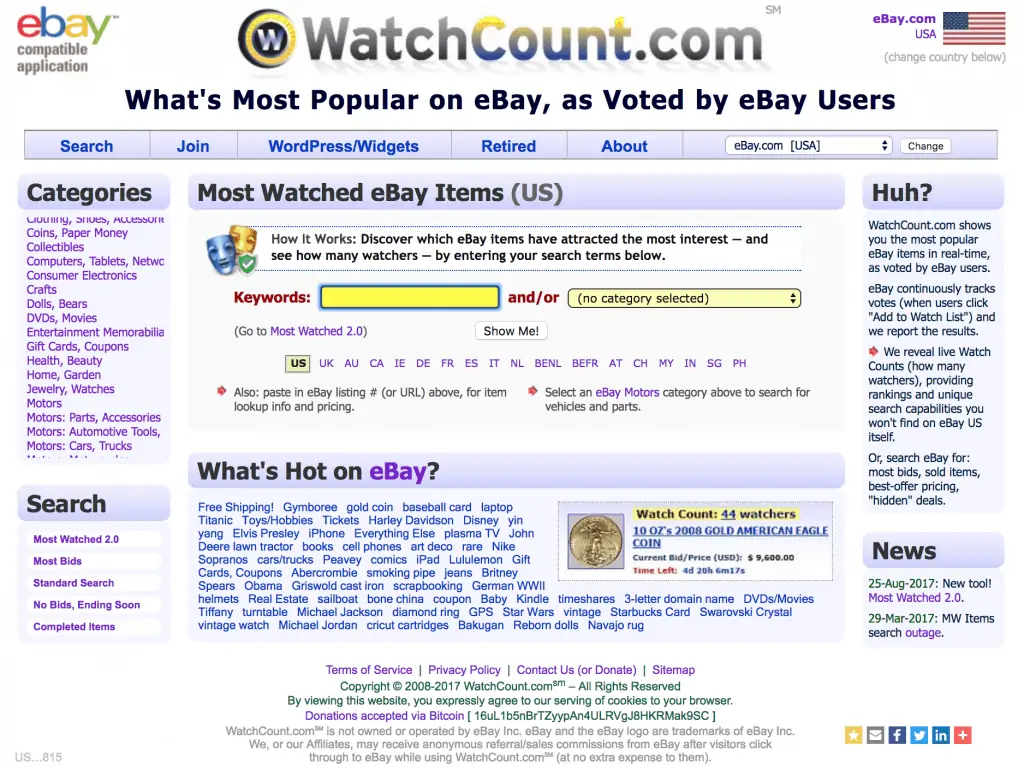
Over at Amazon, you can navigate to the site’s Best Sellers page to view the top-selling products. Items are organized by department, so zeroing in on categories is a breeze. Etsy has a ‘popular right now’ section that allows you to find the most sought after products.

Appeal to a Certain Niche of Products
Another clever strategy you can employ is researching products in demand that belong to a niche category. These products are often requested by ardent consumers who don’t mind spending a higher sum of money for a product they long for. Not to mention, it’s these kinds of customers that remain loyal to a certain brand.
Keep Researching As You Go On
Even if you’ve found the product you want to make, there is always a chance to expand your business. For that reason, we advise you to always keep an open mind and continue to grow by constantly researching your target market and keeping an open mind.
Step 2: How to source your products – finding suppliers
Once you’ve determined what products to sell, you’ll need to figure out how you’re going to source your merchandise. Whether you’re selling readymade merchandise or creating them (and thus need to find vendors to provide raw materials), here are some of the ways to find the right suppliers:
Search through online directories
Thanks to the internet, the perfect supplier might just be a few (ok, more likely several) clicks away. There are plenty of online supplier directories that you can use to find and vet potential vendors. Some of the most popular ones include:
Check out trade group websites
A good way to narrow down your supplier search is to check the website of trade organizations. Most of them have supplier directories that can help you zero in on potential vendors. For instance, the Personal Care Products Council, a trade association for those in the cosmetic and personal care products industry, has a handy search tool for personal care suppliers. Simply Google “[your product or industry] trade association” and you should be able to find relevant results.
Attend trade shows
If you have the time and budget, try to attend trade shows in your industry. This will allow you to meet and greet potential vendors, as well as see their products in person. Again, a quick Google search should help you find the right events to attend.
Ask for referrals
Do you know anyone else in your industry? Ask them about the suppliers that they’ve worked with. It always helps to talk to someone with first-hand experience working with a vendor rather than doing your research entirely online.
Pick up the phone or send an email to your industry contacts and tell them that you’re looking for vendors. And if you’re on LinkedIn, post an update or submit a discussion on relevant groups. You’re bound to come across someone who can point you in the right direction.
Vetting and Communicating with Suppliers
Taking the steps above will help you create a shortlist of companies from which you can source your products or materials. From there, you need to evaluate potential vendors and determine who you’ll work with.
Here’s how you can do that.
Communicate with them – Pay a visit, hop on a call, or send an email to potential vendors and get to know them better. Doing so will not only help you gather more information and get your questions answered, but it will also allow you to evaluate each supplier’s communication skills. This is key, especially if you’re dealing with suppliers overseas. The last thing you want is to miscommunicate or end up with the wrong products or orders.
What exactly should you bring up when catching up with potential vendors? Here are some questions to start with:
- What are your payment terms? (It could be cash on delivery, net 30 days, net 90 days, etc.)
- What are your minimum order requirements?
- What would be the total costs? (In addition to the cost of products, you need to account for shipping costs, handling fees, etc.)
- Can you provide a certificate of liability insurance? (You need insurance in case of recalls, product malfunction, etc.)
- What happens if the orders don’t arrive? (You should know their policies around late or undelivered orders)
Read reviews – Even though speaking directly with suppliers is the best way to evaluate them, it will also help to read vendor reviews. Directories such as ThomasNet and Alibaba often have review sections, so browse their vendor profiles and see what other merchants are saying.
Step 3: Iron out your ecommerce technology and solutions
Done with deciding on products and vendors? Great. The next thing you should do is deal with the “tech” side of things.
Fortunately, this part doesn’t have to be too difficult. Several user-friendly platforms and solutions can enable you to get your store up and running with limited technical knowledge.
But where should you start and what solutions should you go for? That’s what we’ll discuss in this chapter. Read on to learn how you can iron out your ecommerce tech stack.
Hosting and Domain Registration
Hosting
In order for your online business to be successful, you need to pay special attention to the type of hosting you’ll go for, and the provider. The providers vary in terms of features, ease of access, support, and price. Since the choice of hosting deserves a guide on its own, we encourage you to check out our guide on the best ecommerce hosting for 2020.
However, here’s a rundown of the most important things you need to keep in mind before you commit to a hosting option:
- How secure the credit card payments are on that particular server
- If you will have customer support available in case there is a problem or you need help with something
- What the maintenance costs will be
- The storage capacity of the selected server
- If there will be any additional costs
- support
Additionally, if you want a 2-in-1 solution, you can choose a hosted ecommerce platform that includes hosting for your store. But more on that later!
Domain Registration
At this point, you may already have a store name in mind. Perhaps you have your brand and domain name ironed out. If so, then you can proceed to register your domain. However, if you’re still on the fence or have no clue on what domain name to use, check out the following pointers:
Pick a name that communicates your offerings. Ideally, your domain name should tell people what you’re about. For example, a name like “TwirlyGirlShop.com” immediately gives people an idea of what the store sells (i.e. apparel for girls).
Similarly, an online store like “MyVaporStore.com” clearly tells people that it’s an electronic cigarette retailer. Try to aim for that level of clarity for your domain name. While there’s always room for being clever and unique, you should be able to convey the main message of your ecommerce business.
Needless to say, there are some exceptions to this. Several retailers have successfully built thriving ecommerce businesses on domains that don’t spell out what they’re about. Baby product store Honest.com and online furniture retailer Wayfair.com are examples of this.
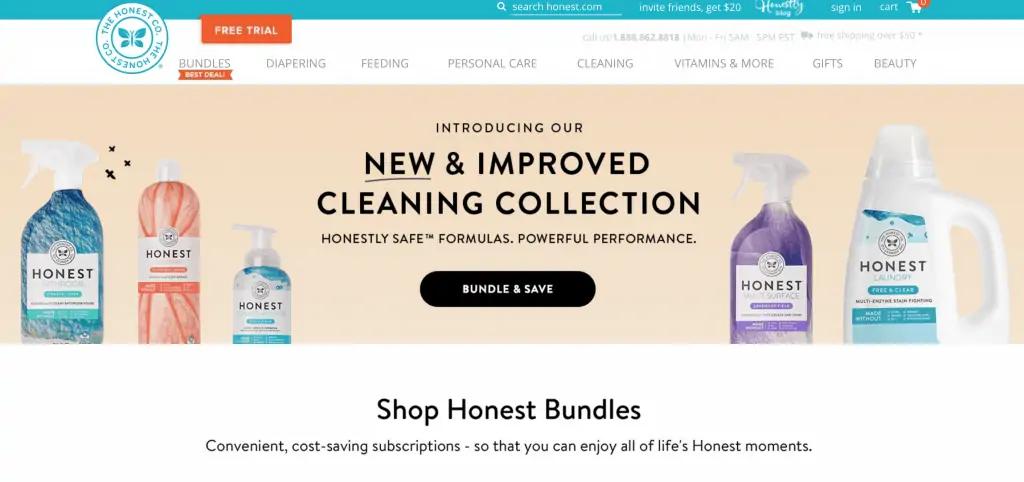
Do note, however, that these companies have significantly invested in branding and marketing to be able to pull that off. So if you’re planning to use a domain that does not immediately convey what your products are, be prepared to ramp up your branding and marketing efforts. (See chapter on marketing later on.)
Another tip is to keep your domain name short and sweet. Doing so increases memorability, makes it easier to enter, and reduces typos that can lead to the wrong website. It’s also best to pick a name with simple spelling and pronunciation — you’d be doing yourself and your customer a favour.
Use domain naming tools. If you’re struggling to find the right domain name, there are a number of online tools that can help you come up with one. Here are a few suggestions:
Register your domain
Once you’ve chosen a domain name, you have to register it through an accredited domain registrar. Some of the top ones include:
You’ll need to pay domain registration fees, which will vary depending on which domain name you choose. Domain registrars also run promotions from time to time, so you may want to shop around and check out multiple registrars to see where you can get the most value.
Choose your ecommerce platform
Next up is your ecommerce solution. This is the point where you’ll decide which platform will power your store. There are two main categories when it comes to ecommerce solutions: hosted and self-hosted.
Hosted ecommerce platforms
Hosted ecommerce platforms take care of your hosting and server maintenance for you. These solutions are more user-friendly and are the preferred options for non-technical people who want to build websites themselves.
Many hosted platforms offer easy drag-and-drop capabilities, which can be a boon for non-techie entrepreneurs who want to go the DIY route with their website. Templates are available, and the popular platforms often come with built-in inventory management, marketing, sales, and reporting features.
Pros of Hosted Ecommerce Platforms
Here are the pros of using a hosted ecommerce platform.
- Hosted ecommerce platforms are easy to manage. The website layouts are beginner-friendly and easy to navigate, so if you’re new to ecommerce, it’s definitely something to consider.
- They offer support. If you’re unsure about how to use a certain feature, or if you have a problem with the platform, you can always turn to their support team.
Cons of Hosted Ecommerce Platforms
What are the disadvantages of going with a hosted solution?
- Some merchants may find these platforms limited because any updates or feature releases will depend on the solution provider.
- Their online store may not be as flexible as the ones built using an open-source platform since the look, feel, and capabilities of their site will be dictated by its specific theme.
- As for integrations, many fully-hosted platforms have preferred add-on providers, so your choices when it comes to third-party solutions may be limited.
Some of the most popular open-source ecommerce platforms include:
Self-hosted ecommerce platforms
Self-hosted ecommerce solutions are open-source platforms that require you to host, implement, and maintain your store. Unless you have a technical understanding of web hosting and ecommerce, you’ll need to hire a developer to help you get your ecommerce shop up and running.
Pros of Self-hosted Ecommerce Platforms
The most significant advantage of using a self-hosted ecommerce platform is flexibility. Open source solutions give you more power over the look, feel, and behaviour of your store. You’re not limited to out-of-the-box features or integrations, and you’ll be able to implement advanced features and customizations.
Cons of Self-hosted Ecommerce Platforms
- Self-hosted platforms are typically more complicated to set up and run.
- Any features or designs must be coded in. And while open-source software may be free, you’ll need to factor in costs such as server fees as well as any spending related to the development and maintenance of your store.
Some of the most popular open-source ecommerce platforms include:
How to choose the right ecommerce platform
Your ecommerce platform is the most important technological component of your store. Not to sound dramatic, but your ecommerce solution can make or break your business. So take the time to find, vet, and choose your platform.
Below are the top factors that you should consider when you’re looking for the right one:
- Hosting
- Features
- Add-ons
- Pricing
Hosting
Will you be going the self-hosted route or sign up with a fully hosted platform? If you’re just starting out and don’t have the coding skills, you may want to consider going with a fully-hosted provider. Setting up your site will be much simpler, and you’ll likely be able to get up and running faster. On the other hand, if you value flexibility and want to implement highly customized designs or features, then an open-source platform might be a better option. Just be sure to budget time and money for hosting and development.
Features
Think about the capabilities that you want your site to have. What features are important to you? For instance, are you planning to sell on Facebook? Do you need a platform with built-in SEO optimization?
Create a spreadsheet and make a list of the features and capabilities that you’re looking for in an ecommerce solution. Label items as “must-have” and “nice to have,” and then go through the features of the platforms that you’re considering to see if they tick the right boxes. Using a spreadsheet format to do this will help you compare ecommerce side-by-side so you can make an informed decision.
Add-ons
Are you planning to use any other software for your ecommerce business? For example, do you have a preferred accounting software? Do you intend to use a CRM program or a particular shipping and fulfilment platform? If so, you may want to check if the platforms that you’re considering can seamlessly integrate with your preferred programs.
Check the add-ons/integrations page of each solution provider to find the third-party apps that they work with. If you see the apps you want, then great. If not, then you’ll either have to build your own integration, settle for a different app that connects with the platform or choose a different ecommerce platform altogether.
Pricing
Ecommerce solution prices depend on a number of things, including the type of platform (i.e., self-hosted vs. fully-hosted), your business size and the features you require, among other things.
Open-source ecommerce solutions are mostly free, but you’ll need to shell out costs for development and maintenance. Meanwhile, most fully-hosted platforms often charge a monthly subscription, which will depend on things like the number of products, the number of users, sales volume, required features, and more.
Action steps to help you evaluate different solutions
Doing online research will undoubtedly help you gather more information about the various solutions out there. Here are a few steps that might be helpful in the process.
Take it for a spin
If possible, take a free trial or demo of the ecommerce platforms that you’re considering. Most of them (fully-hosted ones, in particular) offer trials so you can play around with them yourself. Doing so will enable you to see first-hand how the product works – it will allow you to get a feel of the interface and see if it’s something that you’re comfortable with.
Use your trial to explore the platforms and upload a few products. Check out the available themes and then build a website. Once it’s up, browse your site and evaluate the shopping experience.
Get in touch with sales and support
Hop on the phone with the solution provider’s team or send them a couple of emails. Tell them about your ecommerce business and talk about your needs, your products, and processes, and then ask about how the platform can support your requirements. This also gives you the chance to gauge the company’s communication and responsiveness. Does the provider pick up the phone or answer emails quickly? Do employees answer questions adequately?
There’s a good chance that you’ll interact with your ecommerce solution provider a whole lot, so you want to make sure that they’re there for you.
Check out their clients
See if you can get in touch with similar merchants who are using (or have used) the ecommerce platforms that you’re considering. Ask the solution provider for references. Another option is to visit online forums or LinkedIn groups, and then start a discussion about the providers that you’re considering. You’re bound to come across former and existing customers who can share insights.
Step 4 – Sort Out the Payments side of things
For obvious reasons, payments are an incredibly important part of ecommerce. That’s why you’ll want to make sure that you not only choose the right payment gateway but that it works well with your ecommerce platform.
What is a payment gateway?
In case you haven’t heard of this term before, a payment gateway is a merchant service that authorizes and processes credit card payments for online and offline retailers. Simply put, payment gateways enable you to accept credit cards on your website.
There are several payment gateways in the market, and some of the top ones are:
The primary factors to look at when deciding on a payment gateway are the following:
- Fees
- Payment types
- Ecommerce integration
Now let’s look at them in more detail!
Fees
Each provider has their own fees and ways of determining those rates. Some providers may have fixed costs per transaction, while others have variable percentages or fees. The right choice will depend on your prices and sales volume. Setup, chargeback, and other transaction fees may also apply. In some cases, a payment gateway may charge a monthly gateway fee and other service costs.
Your location and the location of your customers might also be a factor, as some gateways don’t support particular countries. Also, certain gateways charge additional fees if you accept payments from outside the United States.
Payment types
You should also think about the types of payments that you want to accept. Pretty much all payment gateways support credit card payments, but if you’re planning to accept non-traditional forms of payment — such as cryptocurrencies like Bitcoin — then you may need to do some research to ensure that a gateway supports that payment type.
Ecommerce integration
Integrated payments will make your life so much easier. When your payment gateway integrates with your ecommerce platform, your customers won’t have to leave your website to enter their payment information and complete the purchase, making their checkout experience much smoother.
Step 5 – Market your ecommerce business
So, you’ve found an ecommerce platform, set up your payment gateway, and set up your ecommerce website — congrats! Now, it’s time to get the word out and drive traffic to your online store. Here are some of the ways you can do it:
SEO
The best way to get people to find your shop on the web? Make sure it shows on search engines. You need to invest in SEO to get your site to rank in Google search results.
Below are some key steps to take when implementing SEO.
Research is the cornerstone of any SEO strategy. You want to make sure that you’re optimizing for the search terms that are going to attract the best traffic. There are two parts to the research phase of SEO: keyword research and competitor research.
Let’s start with the former.
Keyword Research
Keyword research entails determining the best keywords to target. This is crucial, as ranking for the wrong keywords may attract traffic but not the type of traffic that you’re likely to convert into a lead later down the sales funnel.
How can you find the best keywords to rank for?
A handy tool to use is Google’s Keyword Planner, a free tool that gives you keyword ideas along with information on search volume. Just type in keywords that are relevant to your business, then Keyword Planner will generate a list of keyword ideas, along with information on search volume and competition for each keyword.
For example, if you’re planning to sell organic baby food, you can turn to Google’s Keyword Planner and enter keywords relevant to that topic (e.g. “organic baby food, all-natural baby food” etc.)
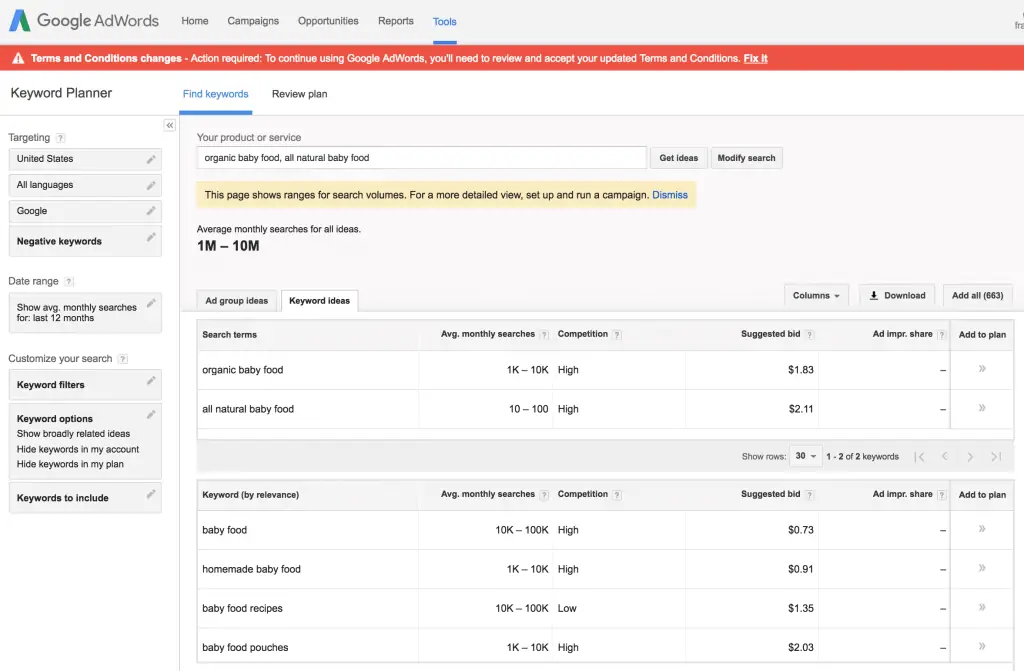
The ideal keywords to aim for are those with a high or decent search volume but with low competition. These are the keywords that will be easiest to rank for, so you might want to start there.
Competitor Research
The other part of SEO research is looking up your competitor’s SEO strategy. You’ll want to become acquainted with the keywords that they’re targeting as well as the websites that are linking to their online stores, as insights on these things will allow you to refine your approach to SEO.
Use a tool such as SEMRush to find your competitors’ best ranking keywords. You can use that intel to decide whether or not you should target those same keywords.
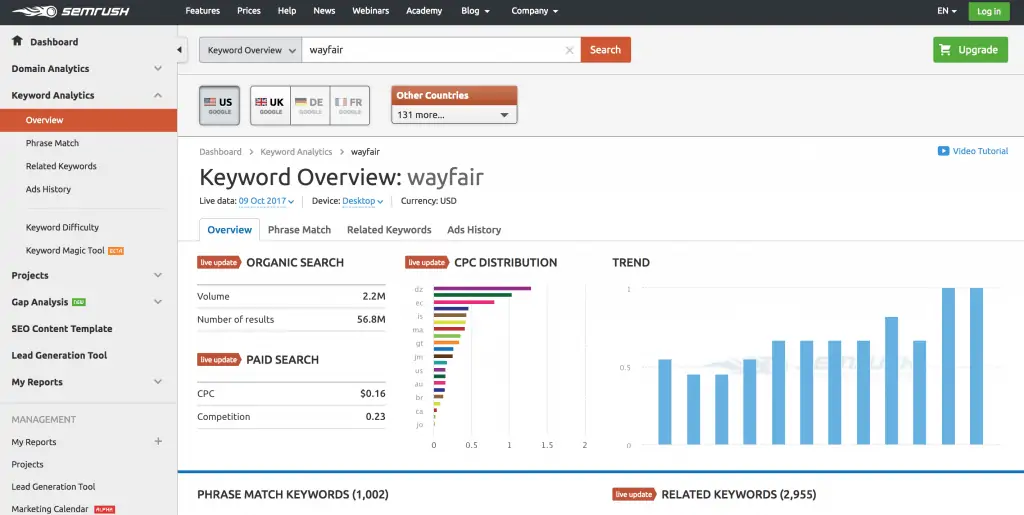
Here’s a tip: if a competitor’s website has a much higher domain authority than yours, then you might find it difficult to rank for the same keywords. If this is the case, it’s best to target other search terms.
Another useful aspect of competitor research is determining which websites are linking back to them. You can do this by using a tool like Moz’s Open Site Explorer which allows you to research backlinks for a particular URL. Doing so will allow you to identify link-building and content marketing opportunities.
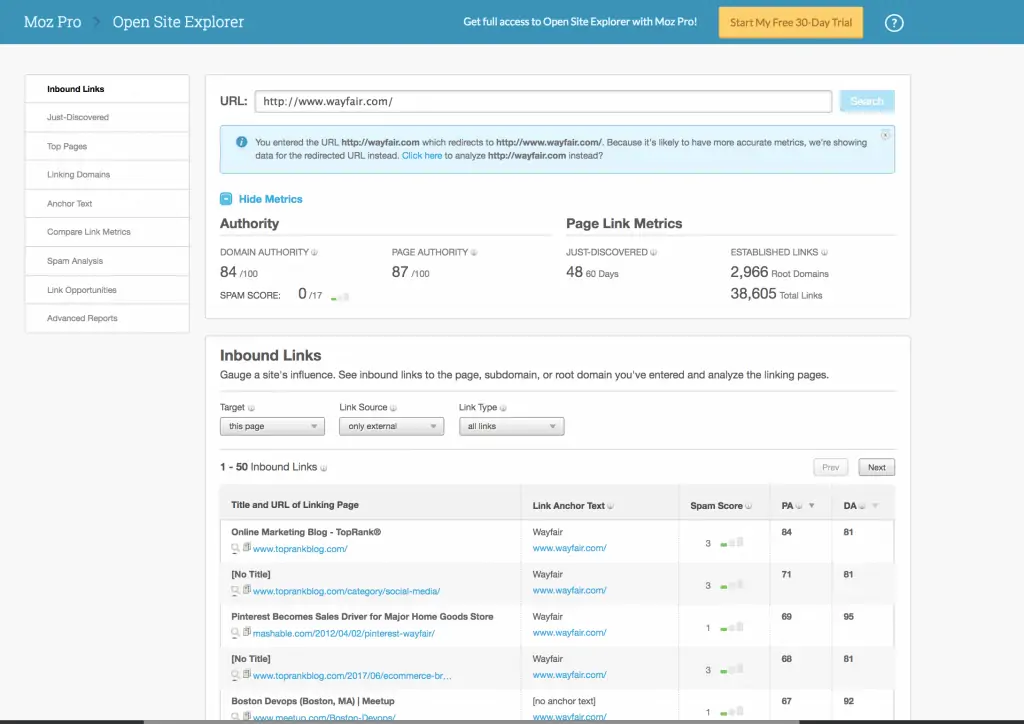
For example, if you’re selling furniture, then you might find that a bunch of home improvement blogs are linking to your competitors. Armed with that info, you might consider reaching out to those same blogs and see if they could link to your site as well.
Optimize your website
You’ve figured out the best keywords to rank for, now it’s time to apply those insights to your website. Take your list of keywords and strategically incorporate it into:
- your page titles and descriptions (include meta titles and descriptions),
- headers,
- web copy,
- and URLs (slugs).
A good rule of thumb here is to create unique content. When coming up with product descriptions, for example, avoid just using what your manufacturer has sent you. Instead, come up with an engaging copy that adequately describes each item.
It’s important to note that optimizing your site isn’t just about incorporating the main keywords. Things like site speed, usability, and mobile-friendliness also influence rankings, so don’t forget to keep these things in check.
See to it that you optimize your website for speed so that it loads quickly and ensure that it’s easy to use on all devices. Test your site on mobile so you can see if it offers a smooth browsing experience. If not, work on optimizing your site for the small screen.
Remember, more and more shoppers are using their phones and tablets to browse the web. If your site provides a dismal experience on mobile, then your mobile search ranking might suffer. And considering that those same mobile users also purchase using their smartphones more than ever, that’s far from ideal.
Build links
Having relevant, high-quality websites link back to your online store will have a positive impact on your rankings, so strive to obtain those high-quality links. As we mentioned earlier, you can start with the sites linking to your competitors. Do a bit of outreach and see if they can include a link to your online shop.
Other ways to get backlinks include:
- Obtaining product reviews from relevant blogs and industry sites
- Getting links from websites in your industry (e.g., being included in a vendor directory in a trade org site)
- Writing guest posts
- Getting media coverage
- Creating content that other sites would love to link to (more on this in the content marketing section)
Content marketing
Having a content marketing strategy can benefit you in many ways. Creating relevant and educational content allows you to engage your audience and peers, and also positions you as a trustworthy authority in your space.
Then there’s the SEO benefit. SEO juice is a byproduct of content marketing. Producing high-quality content that includes targeted keywords and contains the right links can boost your SEO rankings. What’s more, coming up with great, share-worthy content encourages others to link to your site, which further boosts your SEO.
But how do you get started?
You can start with content marketing by figuring out the questions and burning pains of your target audience – by doing keyword research. You should then create content that addresses those questions and concerns, or, in other words, targets the keywords relevant to your niche. The low-hanging fruit here is to create an FAQ page that tackles your customers’ common queries.
And if you want to take things to the next level, consider coming up with in-depth guides and rich resources.
For example, if you’re selling sneakers and athletic shoes, you can create something along the lines of “The Ultimate Guide to Choosing the Perfect Running Shoe”. Selling kitchenware? Why not publish recipes or create resources around kitchen upkeep and maintenance?
One e-tailer that does content marketing well is Blue Bottle Coffee. Their website has a “Learn” section that’s packed with resources like FAQs, brewing guides, courses, and articles. They even have a “Coffee Match” quiz that generates product recommendations based on your coffee habits and preferences.
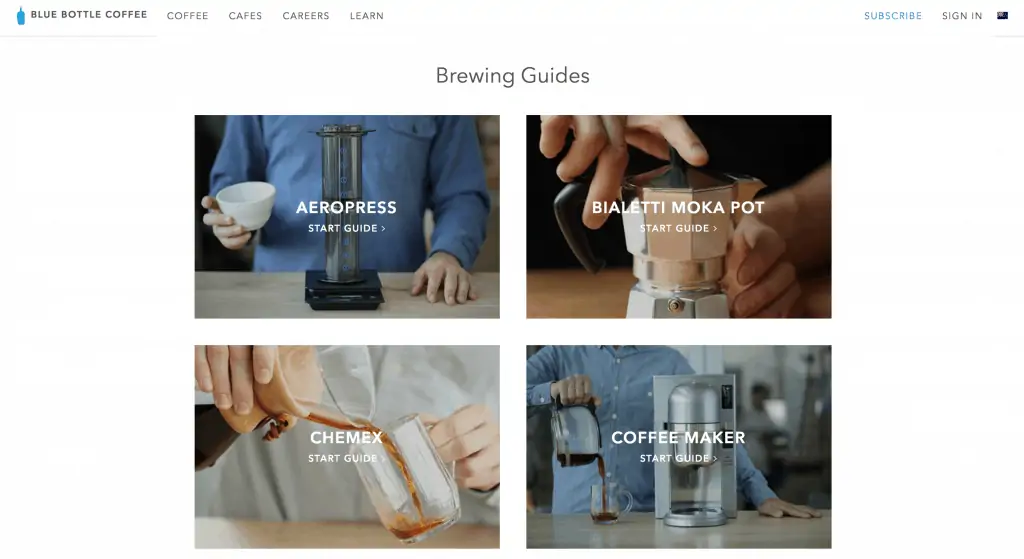
Since content marketing deserves a whole guide on its own, and we’ve only touched upon the basics here, we’ll help you research this in-depth by sharing a few excellent resources on the topic:
- How to Develop a Content Strategy: A Start-to-Finish Guide
- Atomize Your Content: The Periodic Table of Content
- The Ultimate Guide to Remarkable Content
No matter what type of online store you have, there’s a good chance that your customers are on social media. The question is, what social networks are they using? As an online merchant, that’s the first thing you need to ask when crafting a social media strategy.
Do a bit of research on the social media habits of your customers and then figure out where to focus your efforts. Below you can find a bit more information on the most popular social networks out there and how retailers are using them to connect with their audience:
How to market your ecommerce store on Facebook
Facebook is a highly versatile network that allows you to reach and engage audiences in various ways. There’s your Facebook Business page which lets you display company information, reviews, photos, announcements, and more.
Facebook lets you add a call to action to your Page so you can use it to drive traffic to your site. Tory Burch, for example, has a “Shop Now” CTA on its Page.

You can also use Facebook to have actual conversations with your customers. An increasing number of merchants are using Facebook Messenger and chatbots to engage users through instant messaging.
Sephora, for example, has a chatbot that can book consultations and even address customer service requests.

Additionally, Facebook has a robust ad platform with specific targeting capabilities to let you reach and acquire new customers. The platform has several advertising products, including:
- Carousel (Lets you show up to 10 images or videos in a single ad)
- Facebook Pixel (Allows you to measure ad activity and conversions)
- Custom Audiences (For reaching your customers and contacts on Facebook)
- Lookalike Audiences (For finding people similar to your customers and contacts)
- Website Conversion (To Get people to take action on your site)
- Canvas (Lets you use the full screen to showcase your messaging)
- Collection (Lets you display products and get shoppers to purchase)
If you have the budget for it, explore these ad products and see if you can use them in your ad strategy.
How to market your ecommerce store on Instagram
Instagram is an excellent platform for showcasing photos and videos related to your business and products, as it’s a highly visual social network. You can use Instagram to:
- show off your products,
- tell (visual) stories,
- communicate with customers.
For instance, Melbourne-based Kip&Co, which sells bedding and homeware for kids and adults, says that social networks are a crucial part of their marketing strategy.
“As an online business, Instagram forms part of our marketing strategy, our sales strategy, and our customer service,” the founders told Instagram. “It’s how we promote new products, sales and specials, reach new audiences, meet and collaborate with other artists and have a dialogue with customers. We especially love Instagram insights, as they’re super helpful for informing what to post and what products and prints resonate with our customers.”

Another great way to take advantage of Instagram is to publish Stories. If you’re an ecommerce-exclusive retailer, you don’t have the advantage of interacting with customers face to face, so you’ll want to leverage tools that allow you to connect with your audience beyond photos or words on a page.
Instagram Stories can help you do that. Stories give you the ability to give your audience a behind-the-scenes look at your business and processes, which in turn strengthens your connection with your target customers.
One retailer that does this well is Demeter Cerâmicas, a Brazil-based ceramics company. It’s founder, Ana Franco Demeter, advises businesses to take advantage of Stories and use them to show “the public your creative process.”
According to Ana, 80% of her sales come through to her Instagram account, and she’s able to gain those results through good photos and compelling Stories.
How to market your ecommerce store on Pinterest
When used correctly, Pinterest can be a big driver of site traffic. In fact, according to Shopify, Pinterest is the #2 overall source of all social media traffic to Shopify stores.
So, how can you use this network to your advantage? Well, the first step is to pin beautiful images of your products. This will enable you to showcase your merchandise on your Pinterest account, and it will give your followers a chance to re-pin your images.
You might want to consider adding the “Pin It” button to your website to give your visitors the opportunity to pin your products. Additionally, you should use Pinterest to inspire ideas (which could potentially turn into sales). For example, if you’re selling apparel, then Pin images that would give people outfit ideas. Selling furniture? Post pins of beautiful spaces that could spark home redesign initiatives.

That’s what Lowe’s does on its Pinterest account. The homeware retailer has Pinterest Boards like “Bathroom Inspiration” or “A Kitchen to Dine For” that are filled with gorgeous images that people can use in their own homemaking efforts.
How to market your ecommerce store on Twitter
Twitter may not be as sexy or visual as the above-mentioned social networks, but when used right, it can still offer tremendous value.
Twitter allows you to quickly jump into conversations with customers and industry peers. Many e-tailers are using it to address customer concerns online (or at least point them in the right direction.)
Several brands have also started using Twitter to get quick answers from their audience. Check out this example from Amazon, which used Twitter Polls to figure out what their audience wants them to cover at CES.

Email marketing
Social media marketing is useful and can certainly help you get in front of the right people. There’s just one problem: you don’t “own” your audience on social media. The visibility of your content on social networks is controlled by the algorithms and policies of each site or app.
So if a social network decides to tweak how it delivers or displays your content, your visibility might get affected.
That’s why it’s always a good idea to have an audience that you own. That’s where email marketing comes in. When you have an email list, you have full control over how and when your messages are delivered, making email marketing a powerful mode of communication and promotion.
If you haven’t done so yet, sign up for an email marketing solution (e.g., MailChimp, Constant Contact, Aweber, Campaign Monitor, etc.) and use it to build email marketing campaigns. For best results, choose an email solution that integrates with your ecommerce platform.
Start collecting email addresses by setting up an opt-in box on your website inviting people to sign up for your mailing. You may want to incentivize them by offering a perk if they subscribe.
Kate Spade, for instance, offers a discount code to reward people who sign up for their emails.
Once you have those email addresses, start communicating with your subscribers. Send them product updates, give them a heads up when you’re running promotions, or just use email to send content that’ll benefit them.
Here are some examples:
Energy Muse sends messages to alert customers about sales and promotions.
May also like: Ecommerce In The Mobile Age

Dollar Shave Club uses email marketing to make sure its customers know about their free app.
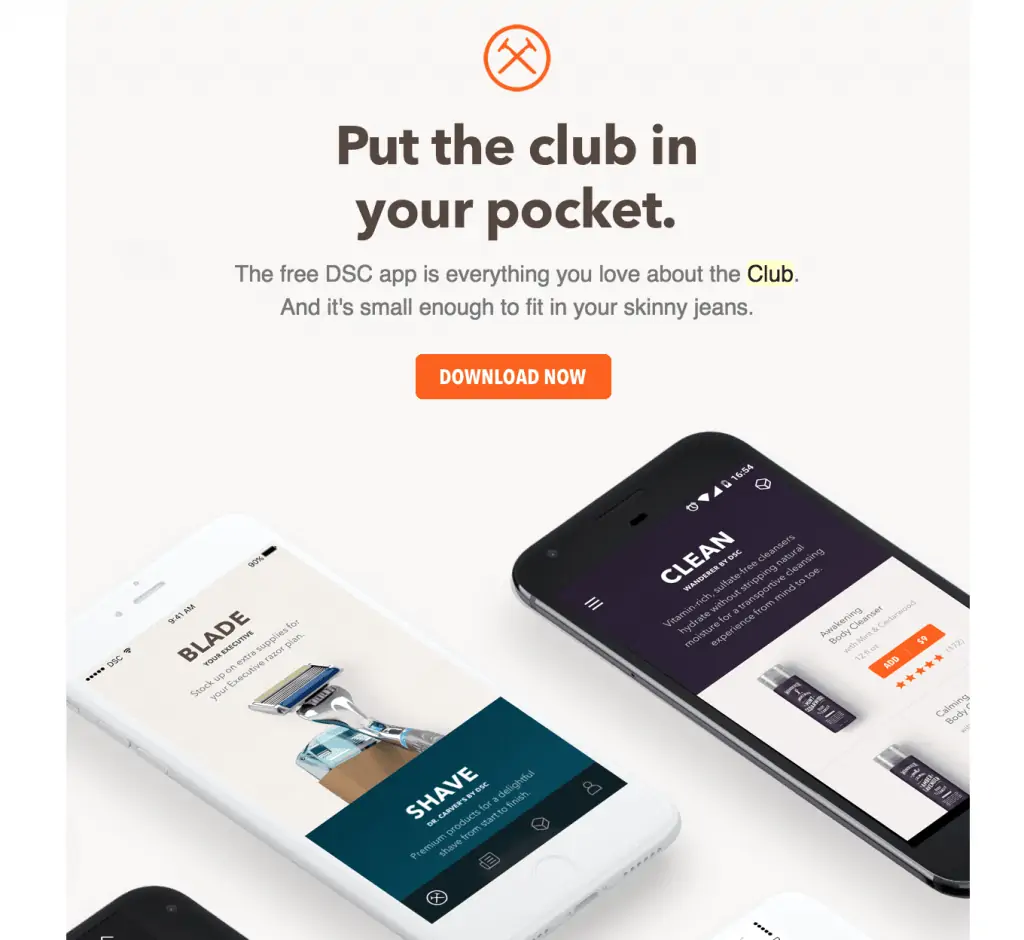
Enfagrow sends educational content straight to your inbox.

Step 5 – Measure business performance
Your ecommerce store is all set up, and your marketing efforts are driving traffic and sales. It’s time to look into your ecommerce data to measure results and performance.
How you carry out this step may vary depending on your store setup and ecommerce platform, but typically, you should be able to get the measures you need by looking at your platform’s reports and by using Google Analytics.
Here are some of the top metrics you should look at:
Site traffic
How many visitors are you getting per day, week, or month? How do customers find your site (e.g., search, social media, third-party sites)? Where are they located?
Looking at your site traffic will help you answer the above questions so that you can make smarter business decisions.
For example, knowing how people are discovering your site could tell you which channels are worth investing in. Let’s say most of your visitors are finding you from Instagram. That insight tells you that it might be worth doubling down on that social network.
Or, knowing where your customers are located could help you implement more localized campaigns or website features. You could, for instance, start displaying prices in a particular currency if you know that most of your visitors are from a specific country.
Conversion rate
Your conversion rate tells you if people are buying your merchandise.
A low conversion rate could indicate a number of issues. It could mean you’re attracting the wrong audience. Perhaps there’s a disconnect between your marketing and your product offerings. Site usability could also be an issue. Maybe your website is too slow, or it isn’t user-friendly, and that’s causing people to bounce.
Whatever the case, if you have a low conversion rate, dig into the issue and try to pinpoint the reason so that you can address it.
Cost per acquisition
Your CPA tells you how much you’re spending to acquire paying customers. The formula for CPA is the total campaign cost divided by conversions. Your CPA measures the effectiveness of your marketing and advertising efforts. It tells you whether a campaign or a channel is worth investing in and helps you allocate your budget accordingly.
Average order value
Your average order value (AOV) can provide insights into customer behaviour and spend. For instance, a low average order value could indicate that you’re selling more of your inexpensive items, and you should ramp up your marketing and sales for your high-value products. It could also indicate people aren’t buying multiple items, in which case it may be time to ramp up your cross-selling efforts.
F.A.Q.
Is Ecommerce Profitable?
E-commerce can be extremely profitable, especially during this time when we’re spending so much time on the Internet. If you have a passion for it, and you dedicate a lot of time and research into this project, then you will profit from it.
How Much Will Starting an Ecommerce Business Cost?
When it comes to the initial costs you will have, it all depends on what you’re selling. You will need to take into account not only the costs for your business, but also side costs like resources, equipment, domain name and website, a potential team of employees, and marketing. On average, it will cost anywhere from $4000 to $10.000.
Is Starting an Ecommerce Business Worth It?
It’s safe to say that regardless of what kind of niche business you want to get into, at the end of the day, if you’re passionate about what you’re doing, if you have patience, and if you remain loyal to your customers, starting an ecommerce business will pay off at the end. You will need to take some risks along the way and make a few adjustments, but you need to trust your instincts and make a plan as soon as possible.
Bottom line
There you have it. The critical steps every merchant should take to create an ecommerce business.
Getting an online store up and running takes work, but if you implement these steps successfully, the rewards of doing so (i.e., profitability and being able to run a thriving Internet business) are tremendous.
Hopefully, this guide brings you closer to achieving that. If you need help starting or growing your ecommerce business, don’t hesitate to get in touch.

